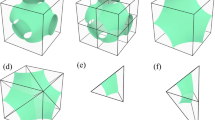Abstract
Generally, the manufacturing of lightweight frame structures involves various processes that yield the final product. Simulation methods can be used to optimise the different process steps. When chaining these process steps together in the simulation, software interfaces become necessary to realise an integrated virtual process chain. In this paper two approaches are presented that solve this issue and demonstrate it for an exemplary part. Different software tools with appropriate interfaces and the use of only one software tool for the simulation of the whole process chain are investigated respectively. The results of both approaches are analysed and relevant conclusions are deduced.













Similar content being viewed by others
References
Schomäcker M (2007) Verbundstrangpressen von Aluminiumprofilen mit endlosen metallischen Verstärkungselementen. Dissertation, Institute of Forming Technology and Lightweight Construction. Shaker, Dortmund, ISBN 978-3-8322-6039-2
Schikorra M, Schomäcker M, Kloppenborg T, Tekkaya AE, Weidenmann K, Kerscher E, Löhe D (2007) Improved properties of aircraft stringer profiles by composite extrusion. In: Proceedings of the international conference on applied production technology (APT-07), Bremen (Germany), 17–19 September 2007, Conference Proceedings, pp 285–292, ISBN 978-3-933762-21-4
Schikorra M (2006) Modellierung und simulationsgestützte Analyse des Verbundstrangpressens. Dissertation, Universität Dortmund. Shaker, Dortmund, ISBN 3-8322-5506-0
Weinert K, Surmann T, Enk D, Webber O (2007) The effect of runout on the milling tool vibration and surface quality. In: Production engineering 1:3. Springer, Berlin/Heidelberg, ISSN 0944-6524 (Print) 1863–7353 (Online). doi:10.1007/s11740-007-0053-5, S. 265–270
Weinert K, Surmann T (2006) Modeling of surface structures resulting from vibrating milling tools. Production engineering—research and development, Annals of the German Academic Society for Production Engineering, XIII, 2, pp 133–138
Foley JD, Van Dam A, Feiner SK, Hughes JF (1995) Computer graphics: principles and practice in C, ISBN 0201848406
Abramowski S, Müler H (1991) Geometrisches Modellieren, Bibliographisches Institut & F.A. Brockhaus AG, Mannheim, Germany, ISBN 3-411-14491-2
Soehner J (2003) Beitrag zur Simulation zerspanungstechnologischer Vorgänge mit Hilfe der Finite-Elemente-Methode. Dissertation, Universität Karlsruhe (TH), Germany
Oh J-D (2004) Modellierung und Simulation des mechanischen und thermischen Beanspruchungsverhaltens metallischer Werkstoffe bei der Spanbildung. Dissertation, Technische Universität Kaiserslautern, Germany
Piendl S, Aurich JC, Steinicke M (2005) 3D finite-element simulation of chip formation in turning. Proceedings of the 8th CIRP international workshop on modelling of machining operations, Chemnitz, Germany, pp 225–234
Weinert K, Biermann D, Kersting M, Grünert S (2008) Experimental and computational analysis of machining processes for light-weight aluminium structures. TTP Trans Tech Publications Ltd, Switzerland, Advanced Materials Research vol 43, pp 97–104
Weinert K, Grünert S, Hammer N, Kersting M (2005) Analysis of circular milling processes for thin-walled space-frame-structures applying FEA-simulation. Production engineering-research and development, Annals of the German Academic Society for Production Engineering, XII, 1, pp 99–102, ISBN 3-9807670-6-x
Weinert K, Grünert S, Kersting M (2006) Analysis of cutting technologies for lightweight frame components. In: Kleiner M et al (ed) Flexible manufacture of lightweight frame structures, TTP Trans Tech Publications Ltd., Switzerland, vol 10 of Advanced Materials Research, pp 121–136, ISBN 0-87849-403-0
Radaj D (1992) Heat effects of welding—temperature field, residual stresses, distortion. Springer, Berlin
Goldak JA, Akhlaghi M (2005) Computational welding mechanics. Springer, New York
Jacobus K, Kapoor SG, DeVor RE (2001) Experimentation on the residual stresses generated by endmilling. J Manuf Sci Eng 123:748–753
Jacobus K, DeVor RE, Kapoor SG (2000) Machining-induced residual stress: experimentation and modeling. J Manuf Sci Eng 122:20–31
Dattoma V, De Giorgi M, Nobile R (2006) On the evolution of welding residual stress after milling and cutting machining. Comput Struct 84:1965–1976
Acknowledgments
This paper is based on investigations of the Transregional Collaborative Research Centre 10, which is kindly supported by the German Research Foundation (DFG).
Author information
Authors and Affiliations
Corresponding author
Rights and permissions
About this article
Cite this article
Zaeh, M.F., Tekkaya, A.E., Biermann, D. et al. Integrated simulation of the process chain composite extrusion–milling–welding for lightweight frame structures. Prod. Eng. Res. Devel. 3, 441 (2009). https://doi.org/10.1007/s11740-009-0190-0
Received:
Accepted:
Published:
DOI: https://doi.org/10.1007/s11740-009-0190-0




